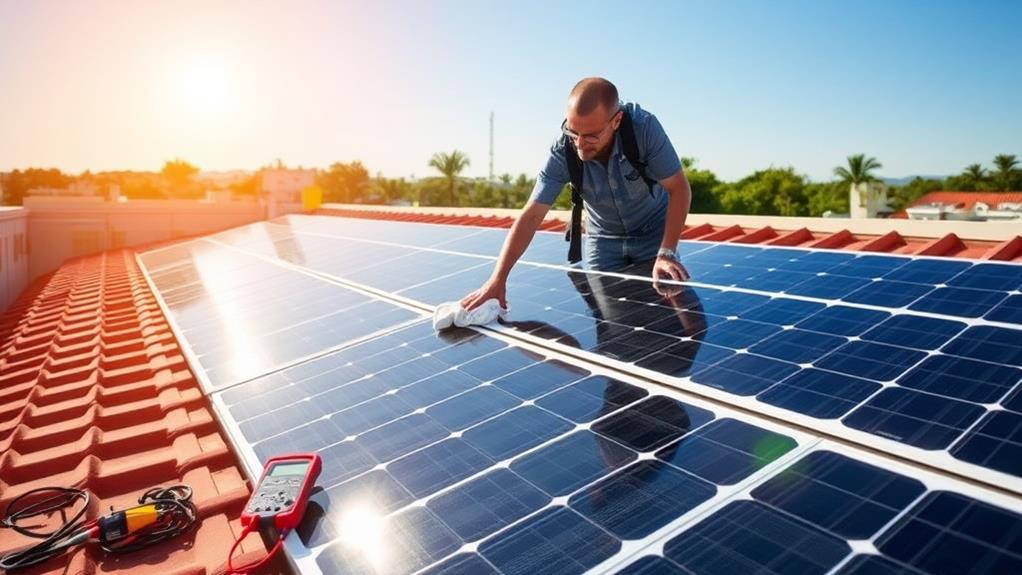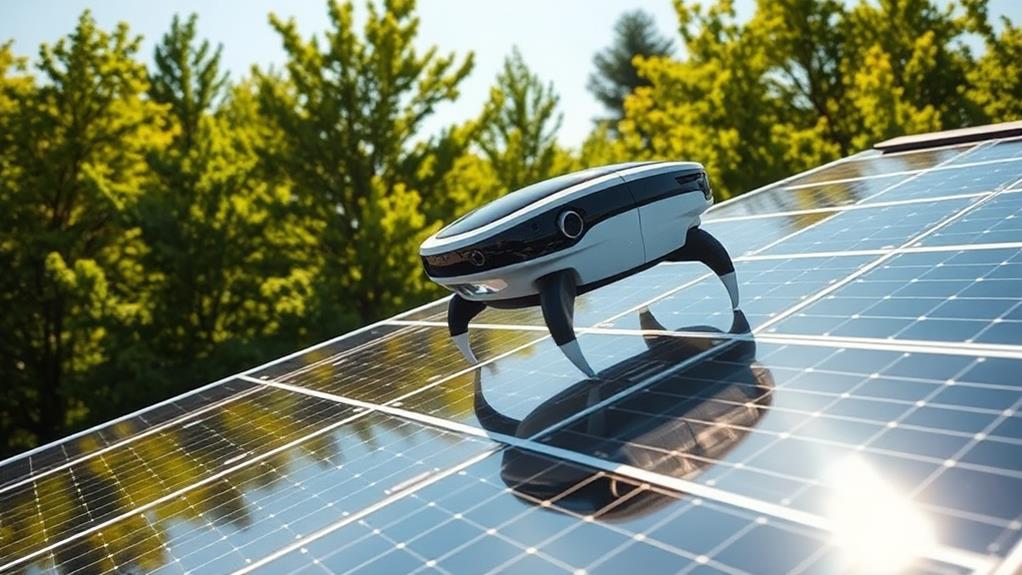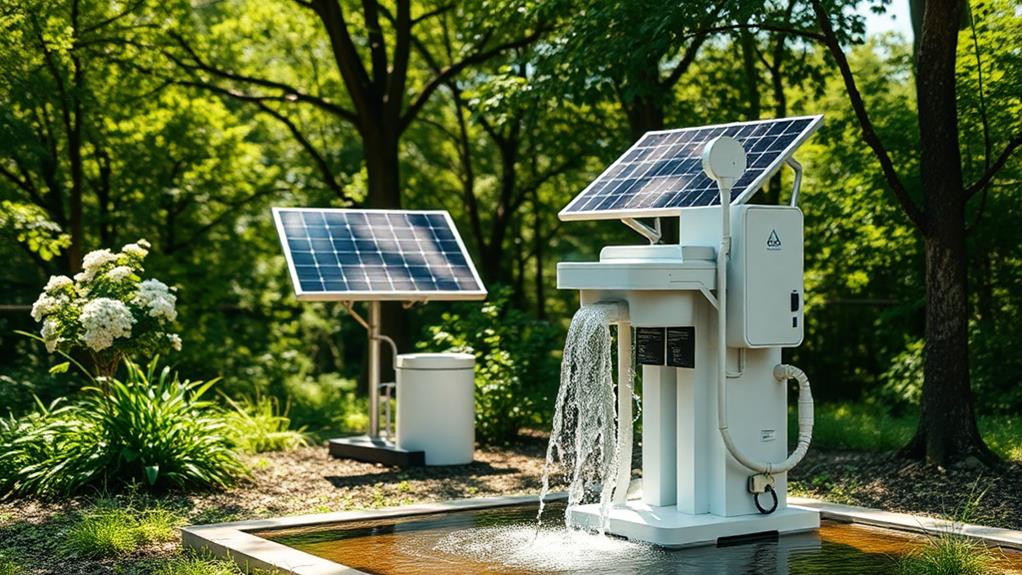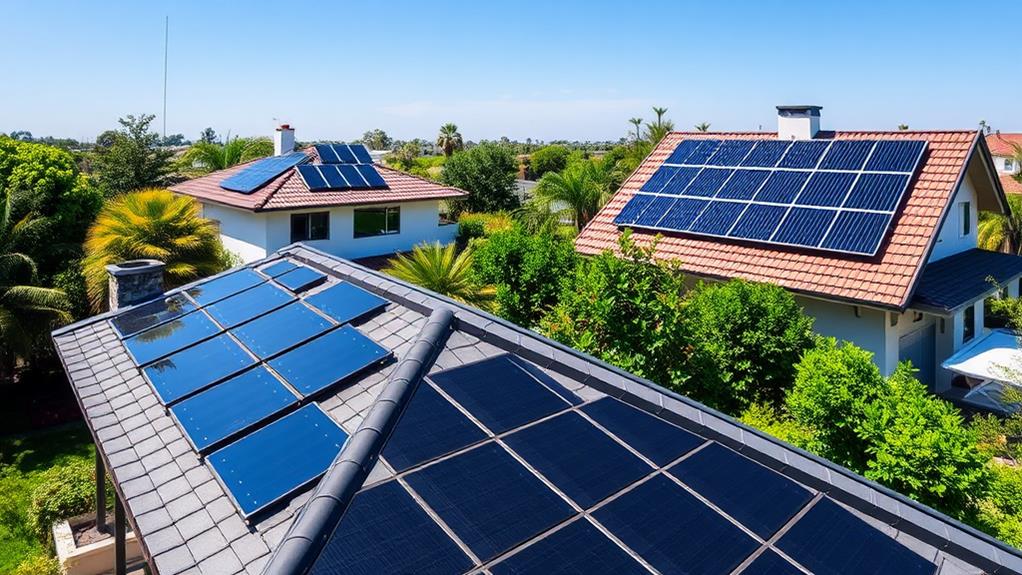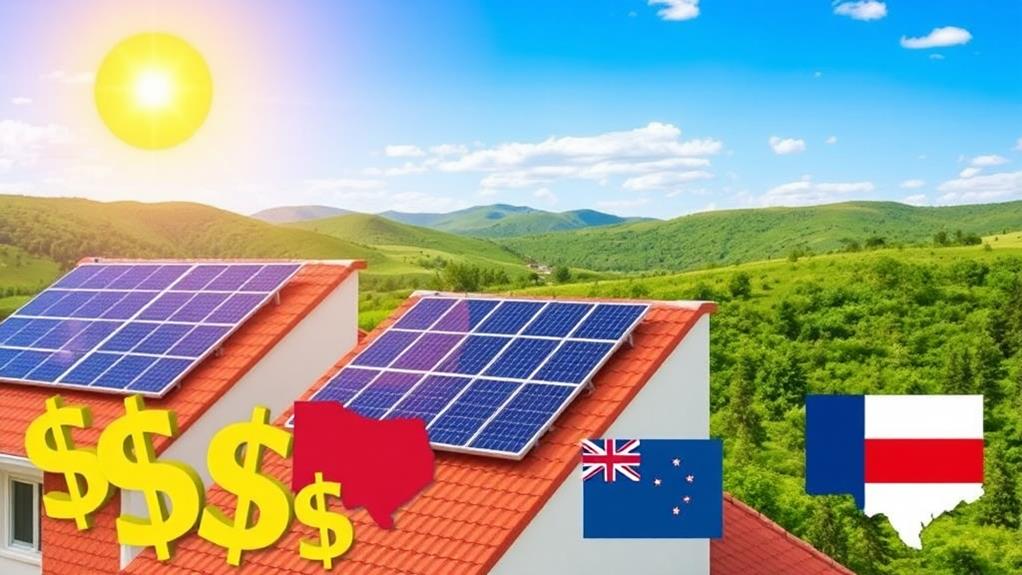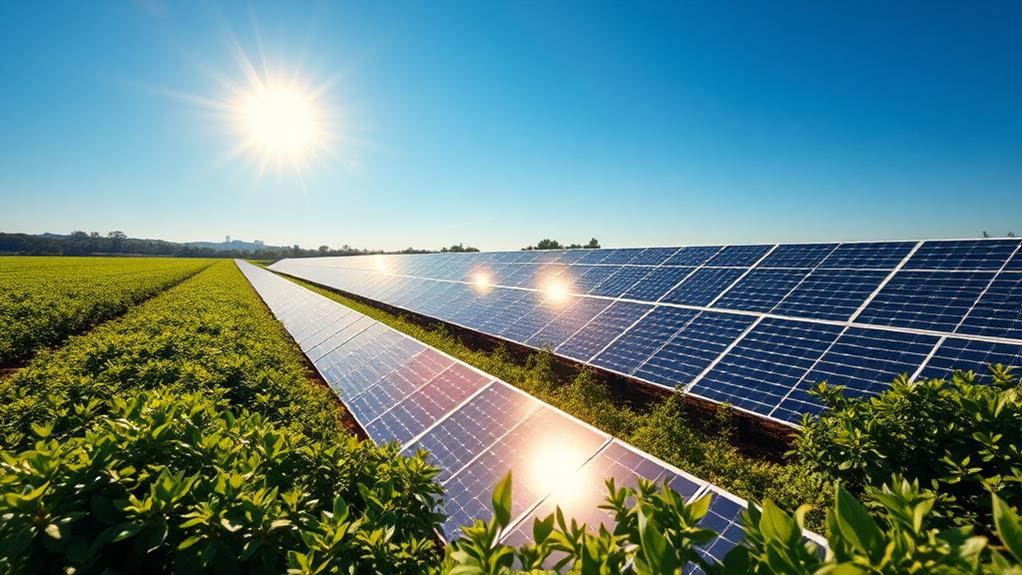Floating solar farms are eco-friendly solutions, as they utilize underused water bodies for renewable energy generation, thereby conserving land for agriculture and urban development. These systems can enhance solar panel efficiency by over 5% and reduce water evaporation by up to 70%, essential in drought-prone regions. Additionally, they foster biodiversity by creating new aquatic habitats while maintaining water quality by mitigating harmful algae growth. These benefits, coupled with reduced land acquisition costs and potential economic advantages, position floating solar technology as a sustainable energy solution that addresses climate change and energy needs, which we will explore further.
Key Takeaways
- Floating solar farms optimize land use by utilizing water surfaces, preserving valuable agricultural land for food production.
- They reduce water evaporation by up to 70%, conserving resources in drought-prone areas and improving water quality.
- Installation can create new habitats for aquatic life, fostering biodiversity while providing clean energy solutions.
- Regular environmental impact assessments ensure minimal disruption to existing ecosystems and monitor water quality effectively.
- Technological innovations enhance energy efficiency, with floating systems generating up to 10% more energy than traditional land-based solar.
Overview of Floating Solar Farms
Floating solar farms are transforming the way we harness renewable energy by making use of underutilized water bodies. By deploying renewable energy technology on these surfaces, we can avoid land use conflicts with agriculture and urban development, maximizing our energy generation potential. Since their inception at the Hapcheon Dam in South Korea in 2012, floating solar farms have gained significant traction globally, with projections estimating the market to reach $2.7 billion by 2025. One of their key environmental benefits is the reduction of water evaporation by up to 70%, conserving essential water resources, particularly in drought-prone regions. Furthermore, the cooling effect of water enhances solar panel efficiency by over 5% compared to traditional land-based installations, optimizing our sustainable energy solution.
Environmental Impacts of Floating Solar
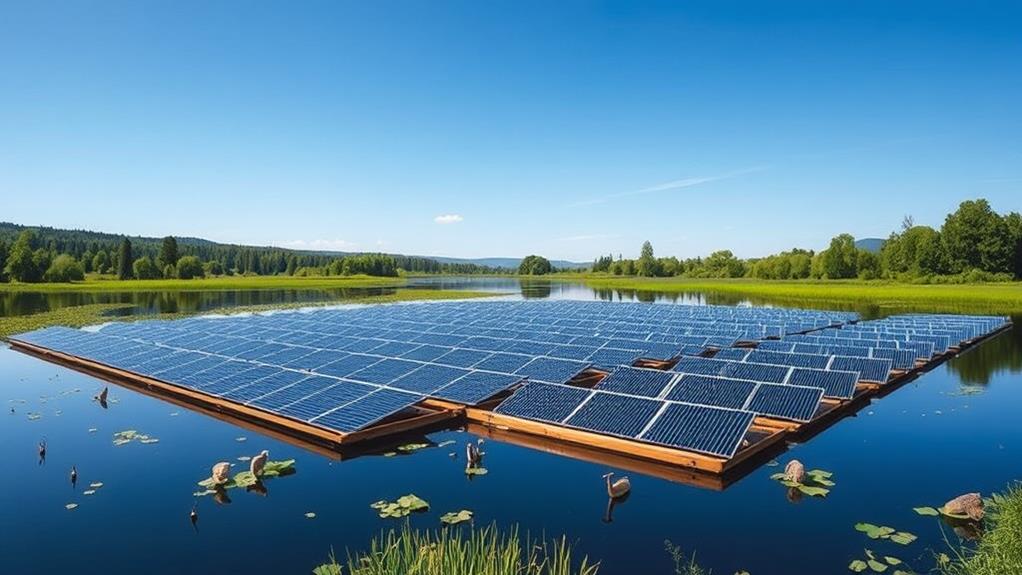
As we consider the environmental impacts of floating solar farms, it's essential to assess both habitat disruption risks and potential water quality improvements. On one hand, while the installation of floating panels can create new habitats for aquatic life, we must also evaluate how these projects might affect existing ecosystems and local wildlife. Conversely, the shading provided by solar panels can lead to significant reductions in water evaporation and lower temperatures, thereby improving water quality and promoting healthier aquatic environments.
Habitat Disruption Risks
The introduction of floating solar farms brings with it a host of environmental concerns, particularly regarding habitat disruption in aquatic ecosystems. These floating solar installations can considerably alter light penetration and temperature, negatively impacting photosynthesis rates essential for aquatic plants. Additionally, the installation process often leads to sediment disturbance, which can harm bottom-dwelling organisms and disrupt natural habitats. Increased underwater noise and vibrations during construction can also affect local wildlife, especially species that rely on sound for navigation. Furthermore, there's a risk of chemical leaching from subpar materials, potentially contaminating water bodies and threatening water quality. Therefore, thorough environmental impact assessments are vital prior to installation, ensuring we evaluate and mitigate these potential disruptions to our precious ecosystems.
Water Quality Improvements
Frequently, we overlook the positive impacts that floating solar farms can have on water quality. These innovative installations not only promote renewable energy generation but also enhance aquatic ecosystems by mitigating harmful algae growth and preserving clean water resources. Through shade, floating solar panels reduce water evaporation by up to 70%, conserving crucial water supplies, particularly in drought-prone areas. Additionally, they moderate water temperatures, fostering balanced biodiversity and maintaining healthy habitats for aquatic life.
| Impact | Details | Benefits |
|---|---|---|
| Water Temperature Control | Lowers temperatures, reducing algal blooms | Improved water quality |
| Evaporation Reduction | Minimizes water loss by up to 70% | Conserves essential resources |
| Photosynthesis Enhancement | Limits light penetration, aiding underwater flora | Supports aquatic biodiversity |
| Regular Monitoring | Identifies contaminants linked to infrastructure | Guarantees clean water resources |
Benefits of Floating Solar Farms

Floating solar farms offer a multitude of benefits that go beyond just renewable energy generation. These floating solar systems not only enhance renewable energy production but also optimize land use by utilizing otherwise underutilized water surfaces, thereby preserving natural habitats for agriculture and wildlife. They can achieve energy generation efficiencies up to 10% higher than traditional systems, thanks to the cooling effects of water. Additionally, these installations greatly improve water quality and aquatic ecosystems; they reduce water evaporation by up to 70%, conserving essential resources, and their shade lowers water temperatures, mitigating harmful algal blooms. Moreover, by fostering biodiversity, floating solar farms create new habitats for aquatic life, contributing to a sustainable energy future and supporting global energy needs.
Technological Innovations in Floating Solar

As we explore the numerous advantages of floating solar farms, it's clear that technological innovations play a pivotal role in maximizing their potential. By enhancing energy efficiency, floating solar arrays can generate up to 10% more energy than traditional ground-mounted systems, thanks to the cooling effects of water. Innovations in buoyancy technology utilize durable, non-toxic polyethylene materials, allowing platforms to support 2.5 times their weight while resisting humidity, ensuring longevity in aquatic environments. Enhanced monitoring systems regularly test water quality, safeguarding aquatic ecosystems by ensuring no contaminants are introduced. Furthermore, emerging designs focus on non-toxic materials that prevent chemical leaching, aligning with our commitment to environmental stewardship. This innovative approach not only protects water quality but also enhances the sustainability of aquatic ecosystems.
Economic Advantages of Floating Solar
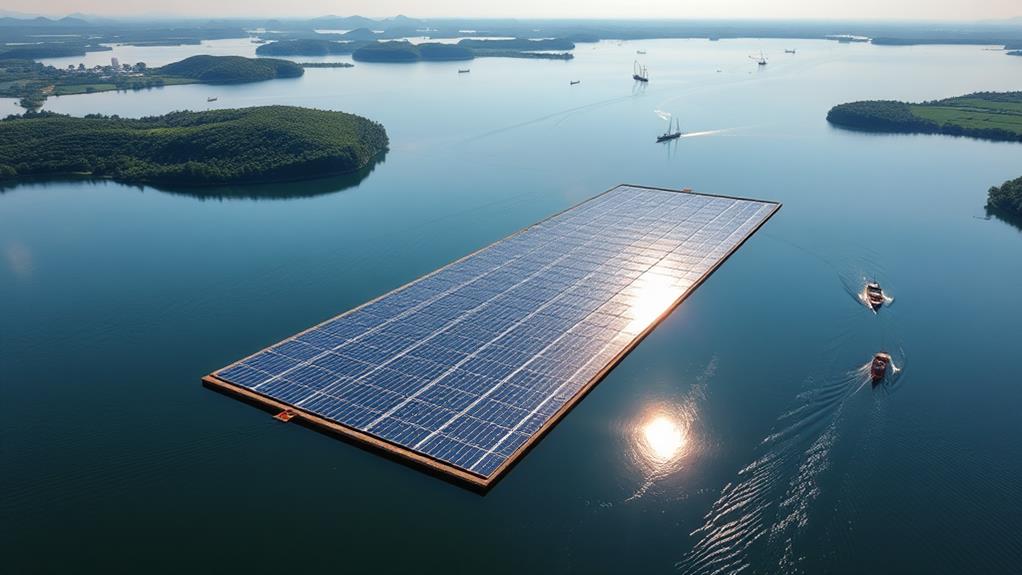
As we explore the economic advantages of floating solar farms, it's clear that their implementation can lead to significant cost reductions, particularly regarding land acquisition, which is vital in urbanized areas with limited space. Additionally, these installations not only generate job opportunities within the renewable energy sector but also attract investment by showcasing innovative solutions to energy production. By maximizing the use of existing water bodies, floating solar systems enhance local energy self-sufficiency while potentially promoting aquatic ecosystems, thereby creating a multifaceted economic impact that benefits communities.
Cost Reduction Benefits
When considering cost reduction benefits, floating solar farms offer a compelling solution to the challenges of land acquisition and maintenance. By utilizing underutilized water surfaces, we can considerably decrease land acquisition costs, especially in densely populated areas where land is both scarce and expensive. Furthermore, floating solar systems can mitigate water evaporation by up to 70%, conserving essential water resources in drought-prone regions. With lower operational costs stemming from reduced maintenance needs, these systems are often more accessible than traditional land-mounted installations. Additionally, the integration of floating solar technology opens up investment opportunities in the renewable energy sector, driving economic growth and positively impacting local communities. By embracing this innovative approach, we pave the way for sustainable freedom and prosperity.
Job Creation Opportunities
Floating solar farms consistently generate a wealth of job creation opportunities, greatly benefiting local economies. These installations require skilled labor for installation, operation, and maintenance, thereby contributing considerably to employment within the renewable energy sector. Research shows that each megawatt of solar energy installed can create approximately 5.65 jobs, highlighting the immense potential for growth in floating solar technology. Additionally, the construction and upkeep of these projects stimulate related industries, fostering additional jobs in manufacturing, logistics, and support services. As floating solar projects expand, they attract investment, further bolstering economic development in surrounding communities. With projections estimating 24 million jobs in the renewable energy sector by 2030, floating solar represents a promising avenue for sustainable employment and economic advancement.
Investment Attraction Potential
The growth of job opportunities in the renewable energy sector naturally leads us to contemplate the investment attraction potential of floating solar farms. These innovative projects considerably reduce land acquisition costs, particularly in densely populated areas where land is scarce, making them economically appealing. By generating renewable energy locally, floating solar farms enhance energy independence and contribute to local economic growth, fostering job opportunities in installation and maintenance. Moreover, their alignment with sustainability goals attracts funding and investment, promoting advancements in green technology. Additionally, floating solar can improve water quality and reduce evaporation rates, leading to long-term savings in water treatment costs. Together, these factors create a compelling case for floating solar as a viable investment in the renewable energy landscape.
Regulatory Framework for Floating Solar
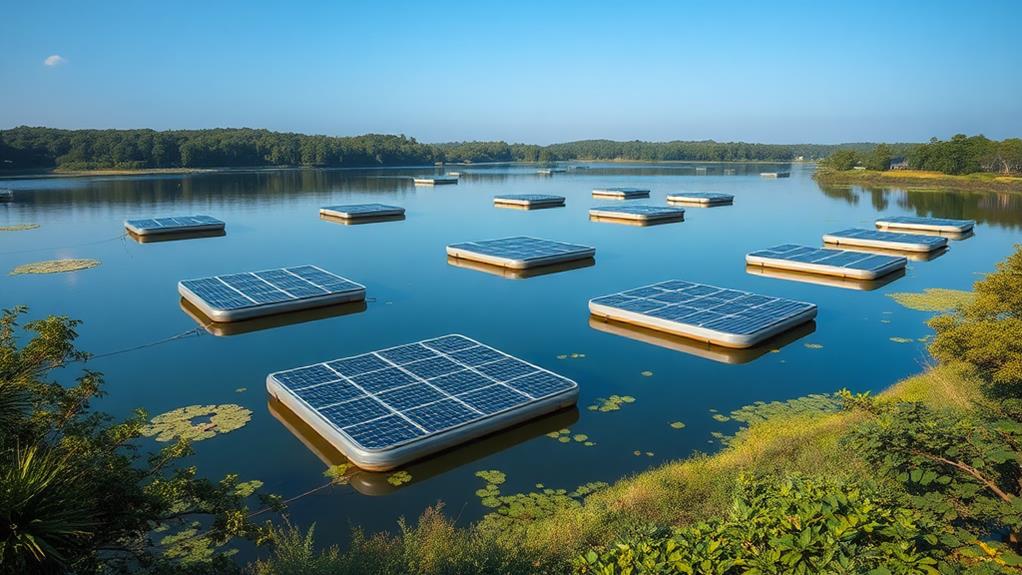
Maneuvering the regulatory framework for floating solar farms involves understanding a complex web of sustainability standards and environmental assessments. These frameworks are essential to guarantee the protection of our natural resources. We must recognize the importance of:
- Selecting non-toxic materials to minimize ecological disruption.
- Conducting environmental impact assessments to evaluate effects on water quality and local ecosystems.
- Advocating for government incentives that stimulate investment in floating solar technology.
- Promoting public engagement to address community concerns.
Through international cooperation, we can share best practices and enhance compliance with regulations, ultimately guaranteeing that floating solar initiatives harmonize with our environment. Together, by maneuvering this intricate regulatory landscape, we can champion clean energy solutions that respect and protect our planet.
Community Engagement and Support

Engagement is essential for the success of floating solar projects, as it fosters local involvement and guarantees residents' concerns are heard during planning and implementation. Effective community engagement strategies not only enhance project design but also greatly increase public support. By integrating community feedback, we can better address local needs, ensuring that the economic benefits, such as job creation during installation and maintenance, resonate with residents. In addition, involving communities in decision-making processes cultivates awareness of the environmental advantages and sustainable practices inherent to floating solar technology. This collaborative approach also aids in communicating potential ecological disruption concerns, enabling us to mitigate them effectively, thereby reinforcing public confidence and support for these innovative energy solutions.
Future Outlook for Floating Solar Solutions

As we look ahead, floating solar solutions are poised to revolutionize the renewable energy landscape. With a projected global market value of $2.7 billion by 2025, the momentum is undeniable. Here are some key factors driving this transformation:
- Efficiency Gains: Technological advancements could enhance energy output by 10% over traditional ground-mounted systems.
- Untapped Potential: Over 400 GW of floating solar capacity remains unexplored, offering vast opportunities for sustainable energy.
- Modular Designs: Future projects will feature scalable setups, adapting to various water bodies.
- Government Incentives: Favorable policies will further stimulate adoption, ensuring we combat climate change effectively.
Together, we can harness floating solar to minimize environmental impacts, paving the way for a cleaner, more sustainable future.
Frequently Asked Questions
Why Is Solar Power Such an Environmentally Friendly Option?
We believe solar energy's eco-friendly nature stems from its minimal carbon footprint, energy efficiency, and reliance on renewable resources. Embracing this clean energy fosters sustainable development, combats climate change, and enhances our energy independence for a better future.
Are Solar Farms Environmentally Friendly?
Imagine sunlight dancing on water, as we harness solar energy through sustainable practices. These solar farms balance land use, conserve water, preserve habitats, and reduce our carbon footprint, nurturing ecological harmony and energizing our quest for freedom.
What Are the Advantages of Floating Solar?
When we explore the advantages of floating solar, we find cost efficiency, land preservation, and water conservation. They enhance energy generation while promoting ecosystem balance, installation flexibility, and maintenance simplicity—truly a technology innovation for climate resilience.
What Are the Environmental Impacts of Floating Solar Panels?
When considering the environmental impacts of floating solar panels, we see enhanced water quality, improved habitat preservation, reduced algae growth, and minimized land use, all while boosting energy efficiency and lowering greenhouse emissions for greater biodiversity impact.


